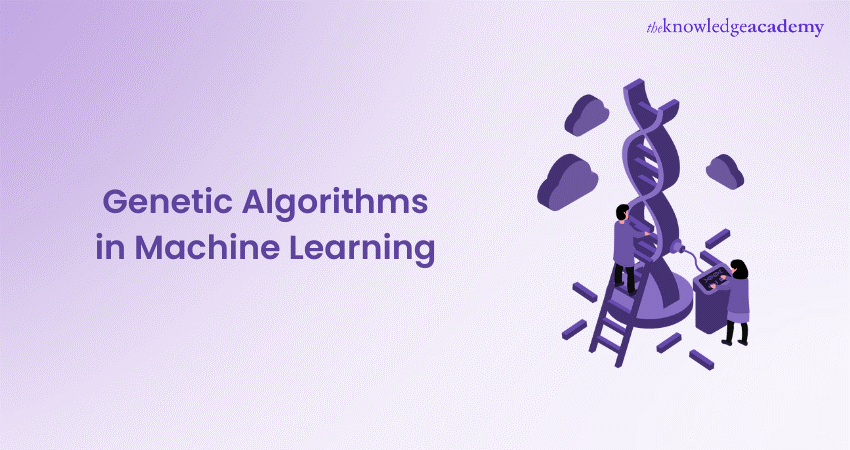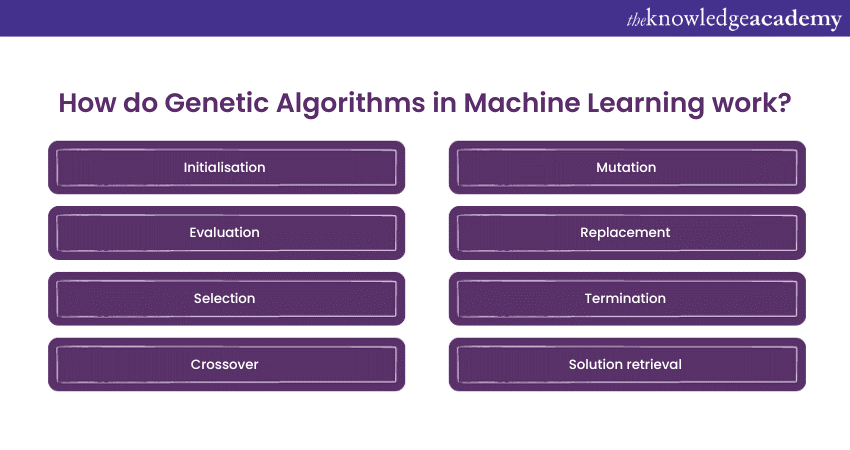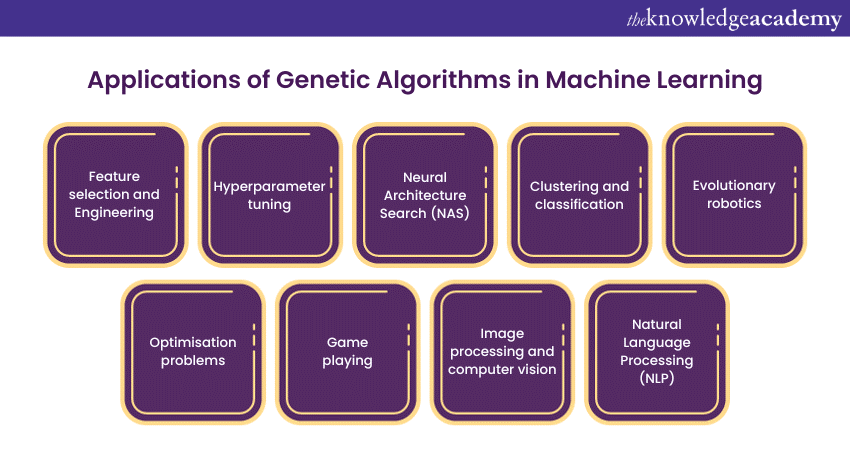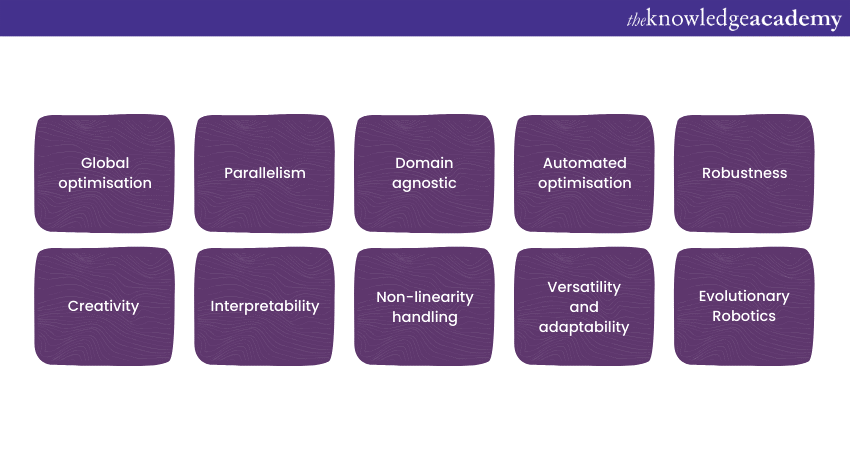We may not have the course you’re looking for. If you enquire or give us a call on 01344203999 and speak to our training experts, we may still be able to help with your training requirements.
We ensure quality, budget-alignment, and timely delivery by our expert instructors.

Genetic Algorithm (GA) in Machine Learning (ML) is a fascinating blend of biology and computer science, offering a unique approach to problem-solving. These algorithms, inspired by the process of natural evolution, are gaining prominence in the realm of Artificial Intelligence (AI). Understanding Genetic Algorithms in Machine Learning will help you unlock their true potential.
If you are interested in learning more about it, then this blog is for you. In this blog, you will learn about Genetic Algorithms in Machine Learning, how they work, their applications, benefits and key challenges. Let's dive in!
Table of Contents
1) What is Genetic Algorithm in Machine Learning?
2) How do Genetic Algorithms in Machine Learning work?
3) Applications of Genetic Algorithms in Machine Learning
4) Benefits of using Genetic Algorithms in Machine Learning
5) Key challenges of Genetic Algorithms in Machine Learning
6) Conclusion
What is Genetic Algorithm in Machine Learning?
GAs are computational techniques inspired by the process of natural selection and evolution. They belong to a broader category of optimisation algorithms known as evolutionary algorithms. These algorithms use principles derived from genetics and natural selection to find approximate solutions to optimisation and search problems.
Unlock the future of AI with our Machine Learning Training – Sign up now!
How do Genetic Algorithms in Machine Learning work?
GAs work by mimicking the process of evolution and natural selection to solve optimisation and search problems. These algorithms are a part of evolutionary computing, a branch of artificial intelligence, and they are used to find approximate solutions in complex and often high-dimensional search spaces. Here's a step-by-step guide to how GAs in Machine Learning works:

1) Initialisation: A population of potential solutions is created. These solutions, often referred to as "individuals" or "chromosomes," are typically generated randomly or with some heuristic knowledge.
2) Evaluation: Each individual in the population is evaluated using a predefined fitness function. This function measures how well each solution performs in relation to the problem being solved. The fitness function quantifies the quality or fitness of each individual and provides a numerical score or value.
3) Selection: Individuals are selected to become parents for the next generation based on their fitness. Solutions that perform better have a higher chance of being chosen for reproduction. This mimics the natural selection process, where fitter organisms are more likely to reproduce.
4) Crossover: Pairs of selected individuals (parents) are combined to produce new individuals (offspring). This is typically done by exchanging genetic information, often referred to as "crossover" or "recombination." The objective is to create offspring that inherit the favourable traits of their parents, potentially leading to improved solutions.
5) Mutation: Some of the newly created offspring may undergo random changes in their genetic information. These changes are introduced through a process called "mutation." Mutation helps introduce diversity into the population, preventing it from converging prematurely to suboptimal solutions.
6) Replacement: The new generation of individuals, consisting of both offspring and potentially some of the previous generation, replaces the old generation. The population evolves as this process is repeated over multiple generations, and the individuals gradually become better adapted to the problem.
7) Termination: The algorithm continues to evolve the population for a specified number of generations or until a termination condition is met. This condition could be a maximum number of generations, reaching a satisfactory solution, or other criteria specific to the problem.
8) Solution retrieval: Once the algorithm terminates, the best individual or individuals in the final generation are considered as potential solutions to the problem. GAs are particularly well-suited for optimisation problems with complex, high-dimensional search spaces where traditional gradient-based methods may not be effective.
Applications of Genetic Algorithms in Machine Learning
Genetic Algorithms have found applications in a wide range of ML domains. Here are some key areas where they have been successfully applied:

1) Feature selection and Engineering: In many ML tasks, the quality and relevance of features play a crucial role in model performance. GAs can be used to search through a vast space of feature combinations to find the subset that results in the best predictive performance. This feature selection process can improve model efficiency and reduce overfitting.
2) Hyperparameter tuning: ML models often require fine-tuning of hyperparameters, such as learning rates, regularisation terms, and network architectures. GAs can efficiently search for the best combination of hyperparameters, optimising model performance and reducing the need for manual tuning.
3) Neural Architecture Search (NAS): Neural architecture search is the process of discovering optimal neural network architectures for specific tasks. GAs can be employed to explore a wide range of network structures, including the number of layers, types of layers, and connections between layers, leading to state-of-the-art deep learning models.
4) Clustering and classification: GAs have been used to optimise clustering Machine Learning Algorithms and classifiers. By evolving the parameters and structures of these algorithms, GAs can enhance their performance and adapt them to different datasets and tasks.
5) Evolutionary robotics: In the field of robotics and autonomous systems, GAs are used to evolve control strategies for robots. This allows robots to adapt and learn behaviours through a process that mimics biological evolution.
6) Optimisation problems: GAs excel in solving optimisation problems, where the goal is to find the best solution among a vast number of possibilities. These problems can range from logistics and resource allocation to game strategies and financial modelling.
7) Game playing: GAs have been used in game playing, especially for developing strategies in complex games like chess, Go, and poker. By evolving the strategies over numerous iterations, they can lead to highly competitive AI players.
8) Image processing and computer vision: In computer vision, GAs have been employed for tasks like image registration, feature detection, and object recognition. They are especially useful in optimising image processing pipelines.
9) Natural Language Processing (NLP): Genetic Algorithms can be used to optimise deep learning model's architecture and hyperparameters. This comes in handy for NLP tasks, such as machine translation, sentiment analysis, and text generation.
These diverse applications demonstrate the adaptability and power of GAs in addressing complex challenges within the Machine Learning domain. They continue to be at the forefront of innovative solutions in AI research and applications.
Master NLP Fundamentals with our Natural Language Processing (NLP) Fundamentals With Python Training – Sign up now!
Benefits of using Genetic Algorithms in Machine Learning
The utilisation of Genetic Algorithms in the field of Machine Learning offers several significant advantages. Here are some key benefits of using Genetic Algorithms in Machine Learning:

1) Global optimisation: Genetic Algorithms are capable of finding global optima in complex, multi-dimensional search spaces. Unlike traditional gradient-based optimisation methods, GAs are not confined to local optima and can explore a broader range of solutions. This makes them well-suited for problems with rugged or non-convex fitness landscapes.
2) Parallelism: GAs are inherently parallelisable, making them well-suited for distributed computing environments. This parallelism allows for faster convergence and the exploration of multiple solutions simultaneously, enhancing their efficiency.
3) Domain agnostic: GAs are not limited to specific Machine Learning domains. From feature selection and hyperparameter tuning to tasks outside the realm of Machine Learning, they can be applied to an extensive range of problems. They can be anything, such as optimisation in logistics or finance.
4) Automated optimisation: GAs automate the process of optimisation. Once set up, they require minimal human intervention, reducing the need for an extensive trial-and-error approach. This makes them valuable for optimising complex models and systems.
5) Robustness: GAs are robust against noisy or incomplete data. They can handle situations where the fitness landscape is uncertain or subject to fluctuations. Their ability to explore diverse solutions and adapt to changing conditions is a significant advantage in real-world applications.
6) Creativity: Genetic Algorithms have an element of creativity in their search process. Through mutation and recombination, they can discover novel and unexpected solutions that might not be evident through manual exploration. This capacity for innovation can lead to breakthroughs in problem-solving.
7) Interpretability: In feature selection and engineering tasks, Genetic Algorithms can provide insights into which features are most relevant to the problem. This aids in model interpretability and understanding the key factors contributing to the solution.
8) Non-linearity handling: Genetic Algorithms are effective at handling non-linear optimisation problems. They can explore complex, non-linear relationships between variables and find solutions that might be challenging for linear optimisation methods.
9) Versatility and adaptability: Genetic Algorithms are versatile and can be combined with other ML techniques. They can complement traditional supervised learning, reinforcement learning, and other methods to enhance performance and adaptability. They can adapt to changes in the problem space or data distribution, making them suitable for dynamic and evolving systems.
10) Evolutionary robotics: In the field of robotics and autonomous systems, genetic algorithms are used to develop control strategies for robots. This allows robots to adapt and learn behaviours through a process that mimics biological evolution.
Overall, Genetic Algorithms bring a host of advantages to ML and optimisation tasks. Their ability to find global optima, work across diverse domains, and automate the optimisation process makes them a valuable tool for tackling complex problems. As Machine Learning continues to advance, Genetic Algorithms are likely to remain a compelling approach for addressing a wide array of optimisation challenges.
Key challenges of Genetic Algorithms in Machine Learning
While Genetic Algorithms offer numerous benefits, they also come with their share of challenges and considerations. Here are some of the key factors to keep in mind when using Genetic Algorithms in the context of Machine Learning:
1) Computational complexity: Genetic Algorithms can be computationally expensive, particularly when dealing with complex search spaces and large datasets. Efficient implementations and parallelisation techniques are essential to mitigate this challenge.
2) Parameter tuning: Like other Machine Learning Methods, Genetic Algorithms themselves require parameter tuning. The choice of different parameters, such as population size, mutation rate, and selection strategies, can significantly impact their performance. Finding the right parameter settings may require time and experimentation.
3) Premature convergence: Genetic Algorithms may converge to suboptimal solutions if not configured properly. Careful attention to parameters and stopping criteria is essential to avoid premature convergence. This includes setting appropriate termination conditions to ensure the algorithm has had sufficient time to explore the search space.
4) Scalability: Applying Genetic Algorithms to high-dimensional problems can be challenging. High-dimensional search spaces may require dimensionality reduction techniques or alternative approaches to maintain efficiency and effectiveness.
5) Influence of initial population: The quality of the initial population can impact the performance of Genetic Algorithms. A poor initial population may lead to longer convergence times or suboptimal solutions. Strategies for generating the initial population should be chosen carefully.
6) Reproducibility: Genetic Algorithms often involve randomness, such as the selection of initial individuals and mutation. This makes it challenging to reproduce results exactly. Researchers must carefully document their parameters and random seeds to ensure the reproducibility of experiments.
7) Complexity of fitness function: The design of an appropriate fitness function is crucial for the success of Genetic Algorithms. Defining a fitness function that accurately reflects the problem and is computationally efficient can be a non-trivial task.
While GAs are a powerful tool, they are not without their challenges. Researchers and Practitioners should carefully consider these challenges and take them into account when designing and using them.
Conclusion
We hope you read and understood Genetic Algorithms in Machine Learning. It represents a captivating synergy of biology and computer science. Their adaptability and creativity make them invaluable for solving complex optimisation problems. Moreover, it helps researchers and practitioners to find innovative solutions in the ever-evolving world of AI.
Embrace the AI revolution and redefine possibilities with our Artificial Intelligence & Machine Learning – Sign up now!
Frequently Asked Questions
What are the Other Resources and Offers Provided by The Knowledge Academy?

The Knowledge Academy takes global learning to new heights, offering over 3,000 online courses across 490+ locations in 190+ countries. This expansive reach ensures accessibility and convenience for learners worldwide.
Alongside our diverse Online Course Catalogue, encompassing 19 major categories, we go the extra mile by providing a plethora of free educational Online Resources like News updates, Blogs, videos, webinars, and interview questions. Tailoring learning experiences further, professionals can maximise value with customisable Course Bundles of TKA.
Upcoming Data, Analytics & AI Resources Batches & Dates
Date
 Python Course
Python Course
Mon 24th Mar 2025
Mon 26th May 2025
Mon 28th Jul 2025
Mon 22nd Sep 2025
Mon 17th Nov 2025






 Top Rated Course
Top Rated Course



 If you wish to make any changes to your course, please
If you wish to make any changes to your course, please


